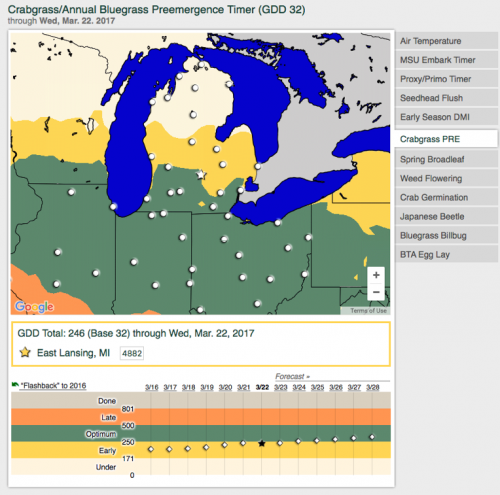Posted on March 23, 2017 by Kevin Frank, Michigan State University Extension, Department of Plant, Soil and Microbial Sciences
Spring 2017 has been a roller coaster ride of temperature peaks and valleys. What started as an early spring with warm temperatures melting snow and many golf courses locally opening the third weekend of February has since stalled. There have been many questions from those tracking growing degree-days (GDD) at GDDTracker this year as to whether or not the models are accurate.
GDDTracker starts counting GDDs on Feb. 15. The crabgrass pre-emergence model uses GDD (base 32 degrees Fahrenheit) to indirectly measure soil temperatures in a turf situation (enter your zip code under the map and then click on “Crabgrass PR”). The GDD model attempts to predict the optimum application timing for when the 0-2 inch depth soil temperatures consistently reach 50-55 F. Applications made at this time provide adequate time for the pre-emergence herbicide to be applied and watered in before crabgrass germination occurs.
Summer annual grasses such as crabgrass require proper soil temperature and moisture to germinate and establish. Eighty percent of germination will occur when soil temperatures at the 0-2 inch depth are consistently between 60-70 F. For pre-emergence herbicides to be effective, they need to be applied before the soils reach this optimum temperature range. At the Hancock Turfgrass Research Center on Michigan State University’s campus, we have yet to record a soil temperature of 50 F at a 2-inch depth. The warmest soil temperature recorded this spring was actually 45 F on March 1, and currently soil temperatures are hovering around 36-37 F, well below the range of 50-55 F we’re targeting.

GDD Tracker pre-emergence model.
Currently, the GDDTracker model has most of the state south of a line from Grand Rapids-Lansing-Detroit in the optimum application window. I think it’s important to remember that these models are meant to serve as “guides” and not absolutes. At least so far it appears the models are ahead of soil temperatures, but also keep in mind the range the optimum application window extends from 250-500 GDD. You don’t have to apply the first day the model indicates optimum.
My best guess, and it’s nothing more than a guess based on the 10-14 day weather forecast, is that the application window GDDTracker is predicting will last into the first couple of weeks of April at a minimum.
In addition to using soil temperatures and GDDTracker, a good environmental indicator for pre-emergence timing is when forsythia bushes are blooming with their bright yellow flowers. Every year I watch a forsythia bush near my office—it happens to be located on the south side of a building so it’s a warm site and usually blooms a little early. I haven’t seen any color from blooms yet.
Although GDDTracker tells me it’s go-time, the other indicators of soil temperature and forsythia blooming don’t. For now, I’d hold off on making crabgrass pre-emergence applications. When it’s all said and done, I’m guessing the typical target date of around April 15 in mid-Michigan will be about right this year. It’s interesting to note that through March 22, 2017, GDDs (246 GDD) are actually behind 2016 (254 GDD).
If you have already applied a pre-emergence application or are still planning on making applications in the next week, the applications will still be effective but you’ll just want to be on the lookout for any late spring/summer crabgrass germination escapes that would require post-emergence control. Another strategy for dealing with an early application would be to follow-up with a “booster shot” second pre-emergence application at half the label rate in approximately 30-45 days after the first application.
Remember, the practices that encourage a healthy, dense turf stand, such as mowing high, returning clippings and adequate fertilization, are all part of an effective crabgrass prevention strategy.
Dr. Frank’s work is funded in part by MSU’s AgBioResearch.
This article was published by Michigan State University Extension. For more information, visit http://www.msue.msu.edu. To have a digest of information delivered straight to your email inbox, visit http://www.msue.msu.edu/newsletters. To contact an expert in your area, visit http://expert.msue.msu.edu, or call 888-MSUE4MI (888-678-3464).